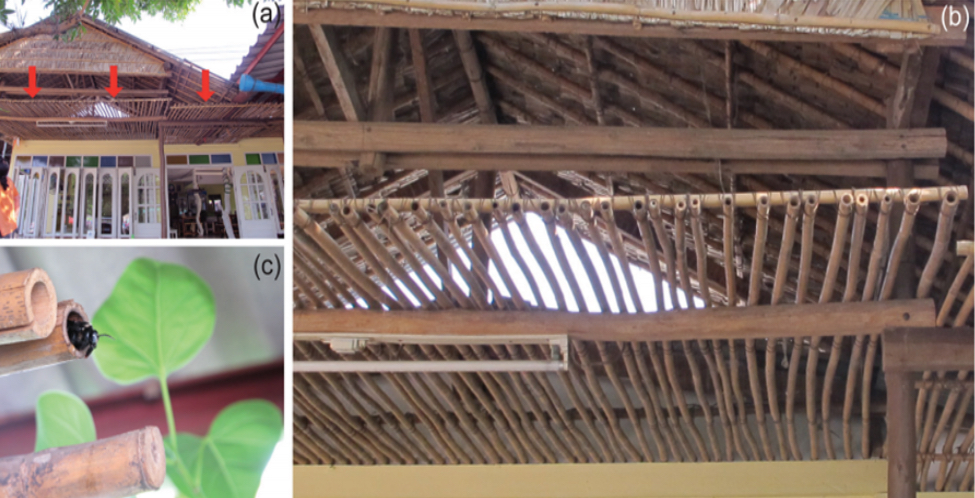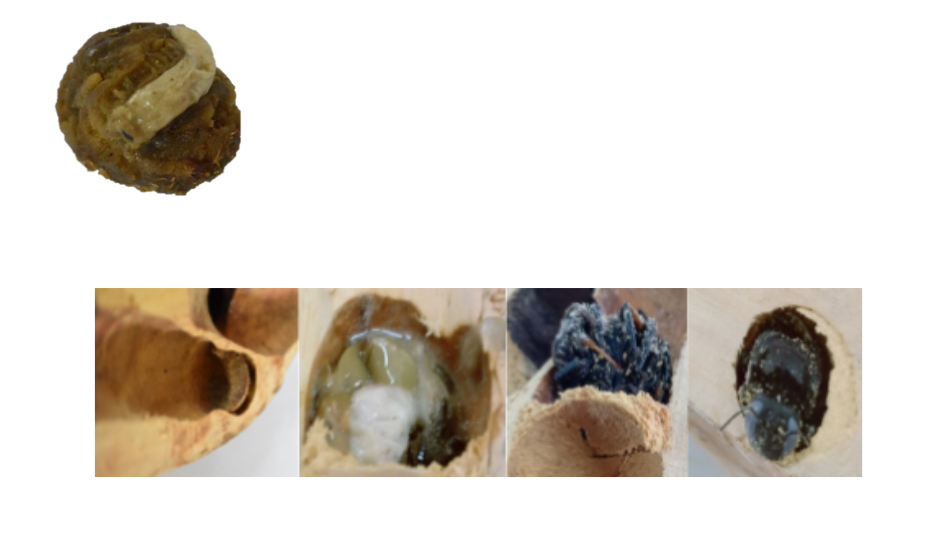การออกแบบมัดท่อรังเทียมสำหรับการนำผึ้งพื้นเมืองมาใช้ผสมเกสรพืชเศรษกิจ
บทคัดย่อ/Abstract
ปัจจุบันผึ้งให้น้ำหวาน (Apis mellifera) ที่เลี้ยงทั่วโลกกำลังลดจำนวนลง เป็นผลมาจากสภาวการณ์ฝูงผึ้งล่มสลาย (Colony Collapse Disorder; CCD) และเกิดการเปลี่ยนแปลงสภาพภูมิอากาศ มีการใช้สารกำจัดศัตรูพืชในภาคเกษตร การศึกษาชีววิทยาของผึ้งพื้นเมืองนอกเหนือจากผึ้งให้น้ำหวาน ที่นิยมเลี้ยงในประเทศไทย สามารถใช้เป็นข้อมูลที่จะใช้ประโยชน์ในการเลือกใช้ผึ้งพื้นเมืองผสมเกสรของพืชผลทางการเกษตร และพืชท้องถิ่น ทดแทนการใช้ผึ้งพันธุ์ ในการวิจัยครั้งนี้ได้แบ่งการศึกษาออกเป็น 2 ส่วน คือ ส่วนแรก ศึกษาชีววิทยาของรังผึ้งช่างไม้ชนิด Xylocopa latipes ซึ่งจากการสำรวจเป็นชนิดที่พบมากที่สุด เก็บตัวอย่างรัง จากกิ่งต้นกว้าว (Haldina cordifolia) ที่แห้งตายแล้ว จากบ้านแหลมสวรรค์ อำเภอสิรินธร จังหวัดอุบลราชธานี ในเดือนกันยายน พ.ศ. 2561 ศึกษาโครงสร้างภายนอกและภายในรัง วิเคราะห์ชนิดเกสรที่พบภายในรัง ผลการศึกษาพบว่า เส้นผ่านศูนย์กลางปากทางเข้ารังมีขนาด 15.46±1.57 มม. รังมีความซับซ้อน ทางแยกหลายทาง จำนวนช่องกั้นตัวอ่อนที่พบมากที่สุดในรังที่คือ 2 ช่อง อัตราส่วนเพศผู้ต่อเพศเมียในรัง (2♂ : 6 ♀) จำนวนสูงสุด 9 ตัวต่อรัง พบเกสรพืช 3 วงศ์ จากก้อนเกสร (Pollen ball) ที่พบภายในรัง ถ่ายภาพภายใต้กล้องจุลทรรศน์แบบใช้แสง สามารถระบุกลุ่มของพืชเกสรที่เป็นชนิดเด่น คือ วงศ์มะหลอด (Elaeagnaceae) วงศ์ขี้เหล็ก (Fabaceae) และวงศ์ก่อ (Fagaceae) ขนาดเส้นผ่านศูนย์กลางท่อนไม้ที่เลือกทำรังมีขนาดเล็กที่สุดคือ 50 มม. รังสูงจากพื้นดินต่ำสุด 3 เมตร สูงที่สุด 6 เมตร จากข้อมูลทางชีววิทยาของรังผึ้งช่างไม้ช่วยทำให้สามารถใช้ข้อมูลสร้างรังเทียม ซึ่งจะเป็นการศึกษาในส่วนที่สอง เพื่อให้ผึ้งช่างไม้เข้ามาอยู่อาศัยและเพิ่มจำนวน จนสามารถนำไปประยุกต์ใช้ผสมเกสรเพื่อเพิ่มผลผลิตพืชผลทางการเกษตรได้ในอนาคตต่อไป
The biological study of wild bees in the genus Xylocopa latipes can provide useful information that may help with the pollination of food crops and native plants in agricultural areas. At present, the bees have decreased all over the world as a result of bee collapse or CCD and climate change has caused widespread use of the bee group in agricultural fields. Therefore, the study of the carpenter bee nests of X. latipes (n=10) in Haldina cordifolia at Ban Laem Sawan, Sirindhon district, Ubon Ratchathani province on the September 2018. The result shows that the nest entrance is 15.46±1.57 mm. and the maximum number of provisioned cells is two. X. latipes constructs branched nests with nest entrance mostly located at the open-end, digging tunnels or holes in the selected wood. Nine adults inhabiting in a single nest. The pollen types were identified from 4 pollen masses using visualization under the light microscope. Three pollen types were considered as major pollen sources. The dominant pollen sources are the families Elaeagnaceae, Fabaceae and Fagaceae. The nesting architectural details should prove to be beneficial to beekeepers and researchers who are interested in trapping and studying X. latipes for future crop pollination.


